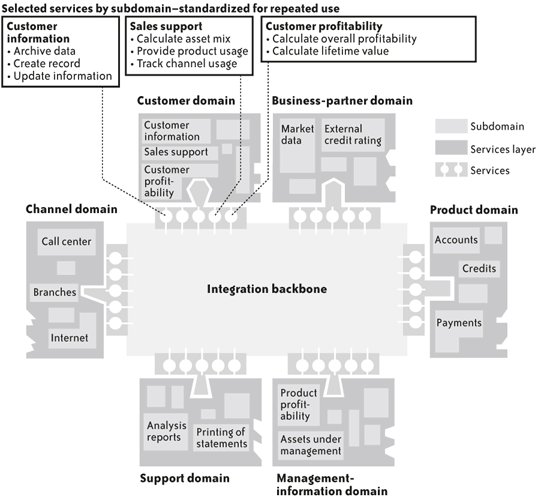Section 17.5. Who owns enterprise services? Who makes a decision about creating new services?
17.5. Who owns enterprise services? Who makes a decision about creating new services?So far in this chapter, we have discussed only two models of governance: centralized and decentralized. A decentralized model ultimately works against standardization, and since enterprise services are built on standards to ensure interoperability, a decentralized model cannot be recommended. A centralized governance model is in some cases a good choice. In this scenario, all services are centrally owned, ensuring standardization. Everyone in the enterprise (with the proper roles and authorizations) can compose with those services freely, creating composite applications based on existing services. A decision-making process is needed only for the creation of new services. After all, a proposed new service might be more strategically created as an adaptation of an existing service, maximizing reuse instead of creating redundancy. No one will argue that new services must be subject to a decision-making process. But there is another and perhaps better choicea federal governance model that enables IT to do what it wants most and business units to do what they want most. A central authority exercises control of the underlying technology platform while business units create flexible, composite applications that take advantage of that platform. Dividing ownership of enterprise services by business unit is an alternative to centralized governance. In fact, it now becomes possible to reorganize the business landscape as a set of domains,[*] or self-contained entities, within which lie most of the composite apps that will be built. The organization can be carved into domains in almost any way that makes sense: ownership of business processes by line of business is one possible method. Figure 17-1 shows the way one company organized its domains.[
Figure 17-1. Restructuring governance by domains However, in a federal governance model, this brings up some interesting questions and issues: if domains own the services relevant to their business area, business units will find themselves negotiating about what services other domains can reuse for creating composite applications. This will open up new lines of communication among divisions as well as free business units from monolithic rules. For example, instead of a one-size-fits-all policy for the entire enterprise, sales and marketing might have ownership of strategic enterprise services that empower that unit to try out new strategies to respond to changing market opportunities. Because the sales and marketing domain owns the services in question, it can create new composite applications using those services freely, without the need to consult other domains. Domains own services relevant to their needs. While some utility services might be centrally owned and available to all (a retrieval of customer data comes to mind), the door is open for a variety of approaches to divvying up enterprise services ownership. And instead of having IT own all of the services, the decisions about dividing services can be made in a way that makes the most sense from a business perspective. In this framework, business gains the agility it needs to move quickly, to compose broadly, and to innovate. In this way, business units gain unparalleled flexibility. However, tradeoffs remain. The more authority the domains have, the more complex the relationships among domains may become. New sorts of negotiations will be necessary. Over time, however, the interface between domains and centralized governance will become clearer. Some enterprise services at first owned by a given domain may need to be centrally owned, and vice versathese decisions are inevitable. Given time, businesses will strike the right balance between flexibility and complexity, allowing for maximum effectiveness in using ESA in support of strategic business processes. |
EAN: 2147483647
Pages: 265
 ]
]